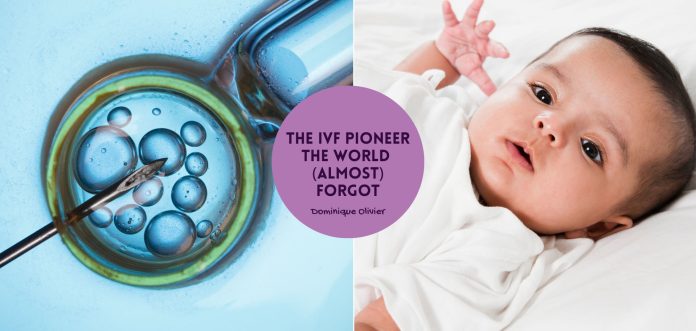Science doesn’t just progress in laboratories. It unfolds in the margins, shaped by the people, politics, and institutions around it. The story of IVF, when told in full, reminds us that breakthroughs are often born twice: once in the petri dish, and again in the public imagination.
Look, I’m sure your mom and dad were really pleased when you were born, but let’s be honest: not everyone’s birth is lauded as one of the most important medical breakthroughs of the 20th century. That distinct honour went to one Louise Joy Brown in 1978, when she became the first human being in history to be born following conception by in vitro fertilisation.
Louise was the first in her family (in the world), and just four years later, the birth of her sister Natalie marked the 40th IVF baby. And when Natalie went on to have her own baby (conceived without IVF) in 1999, she became the first human conceived by IVF to give birth, proving that IVF babies could grow up to be perfectly “normal” reproductive adults (much to the relief of a watching world). That’s a whole lot of firsts for the Brown family!
Fast forward to today, and more than 10 million IVF babies have been born around the world. Estimates suggest that between 1% and 6% of all babies born since 2020 have arrived courtesy of a petri dish.
But there’s a side to this story that most people don’t know. Just 67 days after Louise Brown’s birth, another IVF baby was born – this time in India. Her name is Kanupriya Agarwal, and the man who made her birth possible, Dr. Subhash Mukherjee, used a method entirely different from Edwards’ team, working with far fewer resources and in near-total isolation.
So why wasn’t his name in the newspaper headlines? Well, that’s a question for the Bengal government.
The creation of Louise Brown
The science that brought Louise Brown into the world in 1978 might’ve felt revolutionary, but it had actually been simmering on the scientific back burner for over a century.
Let’s rewind to 1878. While most people were still trying to figure out electricity and internal plumbing, a Viennese embryologist named Samuel Leopold Schenk was already experimenting with fertilising mammalian eggs outside the body. Using rabbits and guinea pigs (science’s most patient test subjects), Schenk mixed sperm with ova in a dish and noted signs of cell division. It was early, imperfect, and not quite a pregnancy, but it was the first whisper of what IVF could one day be.
In 1934, two researchers named Gregory Pincus and Ernst Vinzenz Enzmann made headlines for reportedly achieving the first IVF pregnancy in rabbits. But later scrutiny revealed an important technicality: their fertilisation didn’t happen in vitro (Latin for “in glass”) but in vivo – inside the body. They’d reimplanted their eggs too soon, before they had matured, and nature took over from there. Promising, but not quite the scientific mic-drop they thought it was. In 1959, US scientist Min Chueh Chang successfully used IVF to impregnate a rabbit, officially marking the technique’s first true success in mammals.
In the late 1960s, gynaecologist Patrick Steptoe and reproductive biologist Robert Edwards joined forces after a fateful lecture on laparoscopy. Steptoe had been pioneering this minimally invasive technique to retrieve eggs, while Edwards was obsessed with understanding human fertilisation. Together, they cracked one problem after another: how to mature eggs with hormonal stimulation, how to retrieve them safely, how to fertilise them in a petri dish, and (critically), when to reimplant the fertilised embryo.
By 1976, the duo began working with a couple from Bristol who had spent nearly a decade trying to conceive: Lesley and John Brown. Lesley had blocked fallopian tubes, a hurdle that IVF was uniquely poised to bypass. On 10 November 1977, Steptoe and Edwards tried a new approach: no fertility drugs, just a natural cycle IVF procedure, fertilisation in a humble petri dish, and then implantation.
Nine months later, Louise Joy Brown was born. The media called her a test tube baby. The scientists knew better – it was a petri dish that did the trick. But either way, the world had changed.
The creation of Kanupriya Agarwal
In 2010, at the age of 85, Robert Edwards finally got the nod he’d long deserved: the Nobel Prize in Medicine. His collaborator Patrick Steptoe, sadly, couldn’t be honoured. Nobel rules don’t allow posthumous awards, and Steptoe had passed away in 1988.
The timing of the award felt almost poetic. It landed close to the anniversary of another quiet revolution in reproductive science – one that had unfolded not in Cambridge or Oldham, but in Kolkata. In October of 1978, Indian reproductive scientist Subhas Mukherjee announced the birth of Kanupriya Agarwal – nicknamed Durga – the world’s second and India’s first IVF baby. Headlines at the time, however, only mentioned Edwards’ team and the birth of Louise Brown.
While Edwards’ method involved fertilising an egg outside the body and then implanting it in the uterus, Mukherjee had independently worked out other key pieces of the IVF puzzle. As early as the late 1970s, he had become the first in the world to use hormone treatments to coax ovaries into producing more eggs, the first to harvest those eggs through a far less invasive transvaginal route, and the first to successfully freeze and thaw embryos before implantation.
In a 1997 article in Current Science, reproductive biologist TC Anand Kumar – the man responsible for the birth of India’s second documented IVF baby – told the world that Mukherjee and his colleagues were “ridiculed by the medical fraternity and victimised by bureaucracy”. At the time of Mukherjee’s discovery, the state of West Bengal was barely a year into Left Front governance and had little patience for maverick science. Instead of peer review, Mukherjee got a panel led by a radiophysicist (yes, really) and staffed by scientists unfamiliar with reproductive medicine. Unsurprisingly, they dismissed his work.
It only got worse. By late 1978, Mukherjee was banned by the Bengal government from presenting his findings at scientific conferences. An invitation from Kyoto University was similarly denied. In 1981, he was abruptly transferred to an eye hospital and expected to work in an area of medicine completely outside his field. That July, at just 50 years old, Subhas Mukherjee tragically died by suicide.
The world was led to believe that India’s first IVF baby was born 5 years later in 1986, under the care of the aforementioned Anand Kumar. But in a twist worthy of a detective novel, Kumar later unearthed Mukherjee’s handwritten lab notes, personal correspondence, and experimental logs. After cross-checking with Durga’s parents and scrutinising every technical detail, he reached an unavoidable conclusion: Mukherjee had done it first. Putting his personal accomplishment aside, Kumar vowed to make sure that the world knew that the birth of India’s first test tube baby was the result of Mukherjee’s work, not his own.
It took nearly two decades, but thanks to Kumar’s dogged determination, Mukherjee’s name was finally restored to the record. The Indian Council of Medical Research acknowledged him as the true pioneer behind India’s first successful IVF birth. And Durga herself, who now works as a marketing executive in Delhi, came forward on her 25th birthday to tell the world who she was, and to pay tribute to the man who made her birth possible.
Remembering Subhas Mukherjee
Thanks to the integrity of Anand Kumar, Mukherjee’s work is now recognised in the Dictionary of Medical Biography. It’s no Nobel Prize, but it’s a small, overdue nod in a history that very nearly erased him.
The story of IVF is often told as a tale of science defying biology to offer hope where there was none. But it’s also a story about who gets remembered and why. For every name etched in textbooks, there are others – like Subhas Mukherjee – whose brilliance are buried under bureaucracy, politics, or prejudice. That his legacy now lives on, not only in Durga but in the millions born through techniques he helped pioneer, is a quiet kind of justice. History may be slow to correct itself, but sometimes, it does.
About the author: Dominique Olivier

Dominique Olivier is the founder of human.writer, where she uses her love of storytelling and ideation to help brands solve problems.
She is a weekly columnist in Ghost Mail and collaborates with The Finance Ghost on Ghost Mail Weekender, a Sunday publication designed to help you be more interesting. She now also writes a regular column for Daily Maverick.
Dominique can be reached on LinkedIn here.




